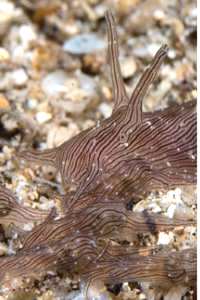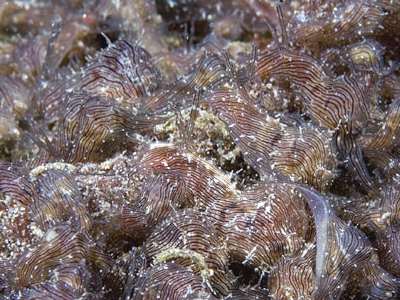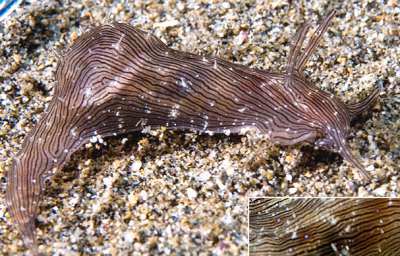1000s of Sea Hares in Hawaii
June 20, 2005
From: Mike Roberts

Hi
Leslie Harris suggested I send you the information and pictures I posted on Digitaldiver.net of a mass of sea hares and one of their predators. I hope this is of interest to you.
Locality: Ulua Beach, Wailea, Hawaii (Maui). Depth: 40-50 ft. Length: varied. 05 and 06 May 2005. Sand. Photographer: Mike Roberts
A couple of weeks ago, I came a across a phenomenon I have seen only twice before in many years of diving Maui. If I wasn’t a photographer or if I had been in that “WA state of mind,” I would have likely missed it altogether. At first glance, it is like swimming by windrows of decay or algae rolling in the surge. These “rivers” are meandering across the sand flowing together, then apart. Some are separate small “streams,” while others are wide flowing “channels.” With a little closer observation, it becomes apparent that these are slugs. Literally thousands upon thousands of Lined Sea Hares [Stylocheilus striatus] to be exact, forming rivers of slugs climbing on top of each other with a definite plan of going south.
On an even closer inspection the individual slugs could be spotted in all sizes from large – for a sea hare anyway – to those that seem freshly hatched
Cute little guys but they were the 'hors deuvres' of the day. Stripebelly puffer fish just rested next to the line of food, looking like so many Jabas while gorging themselves well beyond capacity.
Then I saw a nudi I had never seen before. [see separate message #14082 ] He was a mean machine with body lines that would make Fisher jealous. He was certainly built for speed! This efficient little machine was just zooming along in haphazard patterns until he caught the “scent” of a hare in his path. Then, without missing a beat, the hare would be sucked into his powerful manifold and he would move on to the next one. Even though there were dozens of these sleek nudis driving around in circles and slurping up the little morsels, even though the puffers stationed along the rivers were too fat to swim, the hares didn’t seem to understand they were lunch. But it didn’t matter in the big scheme. They had numbers on their side. And they just kept marching south.
[See Digitaldiver.net -http://www.digitaldiver.net/index.php ]
Mike Roberts
mike@tortuga-web.com



Dear Mike,
Thanks for another record of this fascinating behaviour. We have two earlier records on the Forum of this mass swarming of Stylocheilus in Hawaii [Cory Pittman - #424; John Hoover - #6681]. Have a look at my comments on this phenomenon attached to those messages, and the mass mortality Fact Sheet, where I discuss the mass swarming behaviour found in many Sea Hares. We can't really say why there are so many together like this, so using terms like migration and even aggregation or swarming suggest things which we are not sure about. I tend to think these animals settle out of the plankton and grow close to where they settle only becoming noticeable when the oldest cohort in the population reach adulthood. Perhaps a clue is their food. They feed on a brownish layer of blue-green algae or more properly cyanobacteria. If you look at your upper photo you will see a brownish stain across the sand which is what they are feeding on. I suspect environmental conditions may cause the cyanobacteria to be arranged unevenly on the sand and the 'rows' or 'streams' of Stylocheilus may reflect the distribution of the brown 'stain' they feed on. Whether they are actually 'going anywhere' - like in a spiny lobster migration - is most doubtful.
What makes your record particularly interesting is the observation of the two predators, a species of puffer fish, and the cephalaspidean sea slug Philinopsis cyanea . I have put your photos of Philinopsis in a separate message #14082. Your message on Digitaldiver.net also generated another interesting record of mass swarming in Stylocheilus striatus from the Caribbean [see message #14080]. Any time you witness nudibranchs and related sea slugs 'doing things' like this - think of us obsessive students of sea slugs - such messages are always welcome.
Best wishes,
Bill Rudman
Related messages
-
Sea hare from Isla Marada, Florida
From: W. Robert Hudgins, April 8, 2010 -
Aggregation of Stylocheilus in the Philippines
From: Marcel Tanke, July 21, 2008 -
Re: Line of slugs and aggregations
From: Jean-François Hervé, November 24, 2007 -
Line of slugs and aggregations
From: Kim Friedman, November 5, 2007 -
Stylocheilus swarming in Cuba
From: Alfredo Barroso, September 6, 2007 -
Re: Meeting of the Sea Hares
From: Ann Clear, March 26, 2007 -
Meeting of the Sea Hares
From: Ann Clear, March 23, 2007 -
Re: Swarming of Stylocheilus striatus
From: Everett M.Turner Jr., February 22, 2007 -
Swarming of Stylocheilus striatus
From: Everett M.Turner Jr., February 21, 2007 -
Stylocheilus striatus from Brazil
From: Fabio Amorim, March 22, 2006 -
Stylocheilus striatus from Western Australia
From: Karen Stackpole, March 13, 2006 -
Re: 1000s of Sea Hares in Hawaii
From: Chris Porter, November 30, 2005 -
Aggregation of Stylocheilus striatus in Indonesia
From: Paul Whitehead, November 29, 2005 -
Swarming of Stylocheilus striatus at Bonaire
From: Les Wilk, November 7, 2005 -
Reunion Is - Swarming and spawning of Stylocheilus
From: Philibert Bidgrain, November 5, 2005 -
Re: Stylocheilus striatus swarms at Reunion Island
From: Nerida Wilson, November 3, 2005 -
Stylocheilus striatus swarms at Reunion Island
From: Philibert Bidgrain, October 31, 2005 -
Stylocheilus striatus from Wollongong, New South Wales
From: Sascha Schulz, September 14, 2005 -
Stylocheilus striatus swarming - Turks & Caicos Ids
From: Martin Banford, July 29, 2005 -
Swarming Sea Hares in Hawaii
From: Jim Spears, July 8, 2005 -
Re: 1000s of Sea Hares in Hawaii
From: Mike Roberts, June 23, 2005 -
Stylocheilus swarmimg in the Caribbean
From: Jim Chambers, June 20, 2005 -
White Hawaiian Pleurobranch?
From: Keoki Stender, April 15, 2005 -
Stylocheilus striatus from Brazil
From: Vinicius Padula, February 16, 2005 -
Stylocheilus striatus or S. striata ?
From: Marina Poddubetskaia, January 5, 2005 -
Stylocheilus striatus from Jamaica
From: Ross W. Gundersen, October 21, 2003 -
Re: Stylocheilus striatus (?) from Grenada
From: Marli Wakeling, August 23, 2003 -
Stylocheilus striatus from Grenada
From: Marli Wakeling, August 22, 2003 -
Sea hares & Lyngbya majuscula
From: Steve Arquitt, May 24, 2003 -
Stylocheilus striatus from Lord Howe Island
From: W.B. Rudman, January 27, 2003 -
Stylocheilus striatus from Sulawesi
From: Mary Jane Adams , January 8, 2003 -
Stylocheilus striatus from Florida
From: Linda Ianniello, October 22, 2002 -
Ink Gland in Stylocheilus striatus
From: Angela Capper, September 3, 2002 -
Early larvae of Stylocheilus striatus
From: Duncan Revell, May 25, 2002 -
Feeding in Stylocheilus longicauda
From: Jan Drexel, May 14, 2002 -
Stylocheilus striatus from Balai
From: Stuart Hutchison, March 25, 2002 -
Stylocheilus striatus - veliger larvae
From: Duncan Revell, February 18, 2002 -
Stylocheilus striatus - life history studies
From: Duncan Revell, February 13, 2002 -
Re: Green Nudibranch
From: Timothy Loyd, February 24, 2001 -
Anatomy of a spotted sea hare
From: Brandon, February 22, 2001 -
Green Nudibranch
From: Timothy Loyd, February 21, 2001 -
Sea Bunnies- Florida?
From: John E. Billings, December 15, 2000 -
Microcoleus & Lyngbya
From: Clay Carlson, October 24, 2000 -
Stylocheilus striatus and secondary metabolites
From: Lloyd Godson, October 22, 2000 -
Which sea hare is this one?
From: Phanor Montoya, September 29, 2000 -
Stylocheilus from the Caribbean
From: Barry Lipman, September 27, 2000 -
Re: Another aquaria slug-type creature
From: Michelle Catalano, June 8, 2000 -
Another aquaria slug-type creature
From: Michelle Catalano, June 7, 2000 -
Aplysiid from Coffs Harbour, NSW
From: Carol Buchanan, April 28, 2000 -
Aplysia sp.? from Papua New Guinea
From: Mary Jane Adams, March 20, 2000 -
Stylocheilus as food
From: Bill Rudman, July 23, 1999 -
Breeding & rearing Stylocheilus longicauda
From: Gary Henderson, March 11, 1999 -
Re: Where do I buy Sea Hares?
From: Mark Lanett, February 3, 1999
